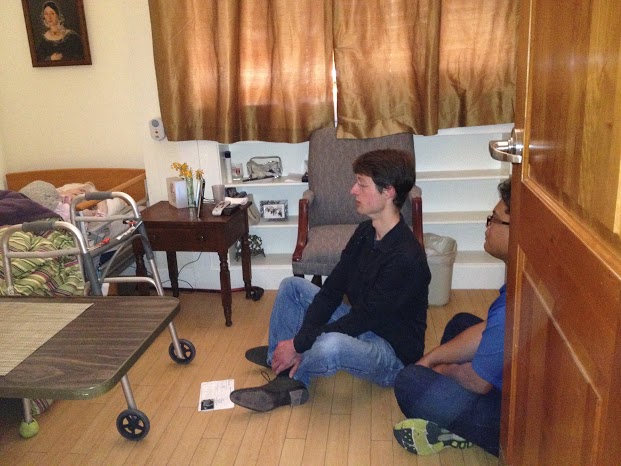Today SevenPonds speaks with Jan Stoneman, a musician and mantram singer who volunteers on a weekly basis at AgeSong—an innovative assisted living facility in San Francisco. He leads groups singing mantrams to AgeSong’s residents, including at bedsides for those unable to leave their rooms. Stoneman holds a Bachelor’s in Music from Juilliard and is currently working on his Masters of Music degree at the San Francisco Conservatory of Music. He started learning about and practicing passage meditation after reading Eknath Easwaran’s Passage Meditation while at Juilliard. His album, “Music for Letting Go,” is set to release in Spring 2015. He speaks with us today about what exactly mantrams are and how do they apply to aging, death and dying.
Zoë: What is a mantram? Can you give us some examples of what you do when you visit individuals in their rooms at AgeSong?
Jan: Mantrams are spiritual formulas that are performed with repetition. They exist in all religions. Mantrams transform negative emotions into positive ones, such as anger into creativity, and greed into selflessness. The beautiful thing about mantrams is that there are no rules. They can be silent or sung. That’s what we do at the wonderful AgeSong. For Catholics, I might sing “Ave Maria” and then move on to Buddhist and Hindu mantrams. I sometimes go into individuals’ rooms when they can’t leave them. One example is when I sang for a lady who wasn’t able to leave her room and was lying in bed when we came into the room. We sat down on the floor next to her cross-legged. We started singing “Barukh attah Adonai,” which means “Blessed art thou, O Lord” in Hebrew. It is a very popular Jewish prayer and mantram. At first, her eyes were closed. We kept singing to her for a while—it was a friend who volunteered and myself—for about five to ten minutes. Gradually, her eyes started glowing and she started mouthing the words with us. A couple weeks later, Sally Gelardin, the Enrichment Director at AgeSong, asked us to sing to the same lady again. Her son was with her because she was on her last leg. He came out and said she was sleeping and then Sally explained what we do. He let us come in. The lady was in pain, curled up, and breathing roughly. We started singing for about five to ten minutes. As soon as we stopped, she exclaimed, “Yes!” Her son explained that she liked it—with emphasis. Seeing her go from sleeping in bed to exclaiming “Yes!” was a pretty powerful experience. She passed away a couple of days later and I sang at her celebration of life. Residents at AgeSong are sometimes agitated—just like I am sometimes agitated—and some talk about their worries. As soon as I start singing, they become calmer.
Zoë: What inspired you to become a mantram singer?
Jan: I have always been into music all my life. I asked myself in college, “How can I change the world? What contribution can I make to people in the world?” I read a lot about Eknath Easwaran, the founder of passage meditation. I started practicing it at the Blue Mountain Meditation Center in Marin County. The root of problems in the world—greed, anger and fear—can truly be helped through meditation. I started trying to figure out what was the best way to transform them in my life. I learned that we need to balance the inner work of meditation by doing service-oriented work outside of meditation. I found my method for service is music. I looked at my spiritual practices and the answer was pretty simple—the mantram. The practice of singing mantrams has a long history. I started composing music to mantrams, which can be found on my website. I wanted direct human contact with my music, not just other people singing mantrams. Eknath Easwaran talked about how when we’re keenly aware that death will come to us; we try to live our lives to the fullest. I wanted to sing to people at the times of their deaths. I wanted to help people close to death to be able to accept the transition by repeating the mantram. It helps during painful times. If you’re able to hold the mantram at all, then you will reach your highest ideal—your clear light, or whatever you want to call it.
Zoë: How does mantram singing apply to aging, death and dying?
Jan: What I’ve learned from Eknath Easwaran and experienced myself is that what’s painful about death and leaving is our attachments. Having an attachment to the body, or to material possessions, makes it painful to leave. It’s painful when we still have selfish attachments to people like hostility or missed opportunities. It’s painful when we’re still attached to our memories. As for aging, the mantram applies because it releases the power we need to pay attention to our families and it will be with us when facing physical pain and the final stages of life. Repeating the mantram every step of the way will take you closer to your goal. By repeating the mantram, you can learn to let go of attachments and come to peace.
Zoë: Your upcoming album is called “Music for Letting Go.” What exactly do you mean by “letting go”?
Jan: Letting go of attachment to body, fears, worries, material possessions and people. Death can be ultimately joyful for you and your family because you’ve let go of all the little things—and big things!—that have held you back.
Jan Stoneman’s 5 Tips for Using the Mantram for Letting Go:
1. Choose a mantram following these free guidelines given by Eknath Easwaran, a world-respected spiritual teacher with a universal, customizable, come-as-you-are approach. You may also check out Easwaran’s The Mantram Handbook.
2. Repeat your chosen mantram as often as possible. So much of the stress and pain in our lives, both physical and mental, can be relieved by giving the mind something to hold on to, so that it doesn’t dwell on unnecessary thoughts, such as worries, resentments, and memories of missed opportunities.
3. Try to find more and more opportunities throughout your day to repeat the mantram, so that it’s there when you need it most. Mahatma Gandhi said, “The mantram becomes one’s staff of life.” Saying it silently in your mind with full concentration is best, but you can also sing it, listen to it, make art with it, speak it, and move to it.
4. Start a mantram forgiveness book. Take a blank journal and write the name of the person whon you want to forgive at the top of the page. Fill that page with your mantram. Death becomes less painful when we forgive and let go of old resentments or hostilities.
5. Ask your friends, family, or care partner to sing or play a recording of your mantram during your final transition. The mantram embodies our highest ideals, and by repeating the mantram at the time of death, we and our loved ones can find much solace. If we have been repeating the mantram so that it has become established as an integral part of our consciousness, the mystics of all religions testify we will be able to hold on to it even at the time of death and merge with our highest ideals.
Zoë: Do you have any advice for our readers who are interested in utilizing mantram singing, particularly with death and dying?
Jan: I suggest you choose a mantram and stick with it. If you keep changing it, you’re like a person digging shallow holes and not finding water. Repeat it often—especially when falling asleep. Continue to ask family to sing it for you when you’re unable to. Make recordings of the mantrams. By having recordings of your mantram, you can have those taking care of you play it for you nonstop, or as often as possible during the last moments. Ask others to sing it for you if they feel comfortable doing so. The pronunciations are not important. To paraphrase Easwaran, “The Lord will understand you no matter how you pronounce it.” When bedridden, a wonderful thing is to write the mantram constantly and fill the pages with it. It will also deepen your experience of singing it. That’s what’s wonderful about mantrams. There are no rules for it.
Zoë: Thank you so much for speaking with us!
Jan: My pleasure!
You may also enjoy:

 What Is Mantram Singing? An Interview with Jan Stoneman
What Is Mantram Singing? An Interview with Jan Stoneman




 Recovering Cremation Remains After the Los Angeles Fires
Recovering Cremation Remains After the Los Angeles Fires
 “As Tears Go By” by Marianne Faithfull
“As Tears Go By” by Marianne Faithfull
 “The Sea” by John Banville
“The Sea” by John Banville














